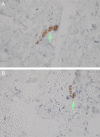Locally invasive classical papillary thyroid carcinoma with TSH receptor I568T mutation: case report
- PMID: 35319493
- PMCID: PMC9002183
- DOI: 10.1530/EDM-21-0192
Locally invasive classical papillary thyroid carcinoma with TSH receptor I568T mutation: case report
Abstract
Summary: Autonomous thyroid adenomas are caused by activating mutations in the genes encoding the thyroid-stimulating hormone receptor (TSHR) or mutations in the Gas subunit of the TSHR. Nodules with suspicious sonographic features should be submitted to fine-needle aspiration. Additional molecular testing may be performed to characterize the thyroid nodule's malignant potential further. We present a patient who underwent whole-transcriptome RNA-sequencing that indicated a TSHR I568T mutation after an ultrasound showed suspicious sonographic features and fine-needle aspiration was 'suspicious for malignancy'. The patient underwent thyroid resection and was found to have a locally invasive classical papillary thyroid carcinoma. Most reports of TSHR I568T mutation have been seen in patients with benign thyroid conditions. While there is insufficient data to suggest that the TSHR I568T mutation causes aggressive thyroid malignancy, we believe clinicians who identify the presence of this mutation on genome sequencing should be cautious about the possibility of locally invasive thyroid malignancy, especially when associated with Bethesda V cytopathology.
Learning points: Germline and somatic activating mutations in the genes coding for the thyroid-stimulating hormone receptor (TSHR) have been frequently reported in familial and sporadic autonomous thyroid adenomas and non-autoimmune hyperthyroidism. Most reports of TSHR I568T mutation have been detected in patients with benign thyroid conditions. We present a patient who underwent whole-transcriptome RNA-sequencing that indicated a TSHR I568T mutation and subsequently underwent thyroid resection and was found to have a locally invasive classical papillary thyroid carcinoma. Clinicians who identify the presence of TSHR I568T mutation on genome sequencing should be cautious about the possibility of locally invasive thyroid malignancy, especially when associated with Bethesda V cytopathology.
Figures


Similar articles
-
Cancer risk and clinicopathological characteristics of thyroid nodules harboring thyroid-stimulating hormone receptor gene mutations.Diagn Cytopathol. 2018 May;46(5):369-377. doi: 10.1002/dc.23915. Epub 2018 Mar 8. Diagn Cytopathol. 2018. PMID: 29516685
-
Clinical Significance of Thyroid-Stimulating Hormone Receptor Gene Mutations and/or Sodium-Iodine Symporter Gene Overexpression in Indeterminate Thyroid Fine Needle Biopsies.Front Endocrinol (Lausanne). 2018 Sep 25;9:566. doi: 10.3389/fendo.2018.00566. eCollection 2018. Front Endocrinol (Lausanne). 2018. PMID: 30319546 Free PMC article.
-
Functioning and nonfunctioning thyroid adenomas involve different molecular pathogenetic mechanisms.J Clin Endocrinol Metab. 1999 Nov;84(11):4155-8. doi: 10.1210/jcem.84.11.6157. J Clin Endocrinol Metab. 1999. PMID: 10566665
-
Shared sporadic and somatic thyrotropin receptor mutations display more active in vitro activities than familial thyrotropin receptor mutations.Thyroid. 2011 Mar;21(3):221-9. doi: 10.1089/thy.2010.0312. Epub 2010 Dec 29. Thyroid. 2011. PMID: 21190443 Review.
-
[Disorders caused by mutations of the thyrotropin receptor].Nihon Rinsho. 1998 Jul;56(7):1856-60. Nihon Rinsho. 1998. PMID: 9702065 Review. Japanese.
Cited by
-
Risk of malignancy in cytologically indeterminate thyroid nodules harboring thyroid stimulating hormone receptor mutations.Front Endocrinol (Lausanne). 2022 Dec 22;13:1073592. doi: 10.3389/fendo.2022.1073592. eCollection 2022. Front Endocrinol (Lausanne). 2022. PMID: 36619548 Free PMC article.
-
Recombinant Human TSH Fails to Induce the Proliferation and Migration of Papillary Thyroid Carcinoma Cell Lines.Cancers (Basel). 2024 Jul 21;16(14):2604. doi: 10.3390/cancers16142604. Cancers (Basel). 2024. PMID: 39061242 Free PMC article.
References
-
- Krane JF, Bibas ES, Endo M, Marqusee E, Hu MI, Nasr CE, Waguespack SG, Wirth LJ, Kloos RT. The Afirma Xpression Atlas for thyroid nodules and thyroid cancer metastases: insights to inform clinical decision-making from a fine-needle aspiration sample. Cancer Cytopathology 2020128452–459. (10.1002/cncy.22300) - DOI - PMC - PubMed
LinkOut - more resources
Full Text Sources

